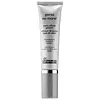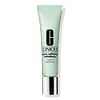Dr. Brandt Skincare Pores No More® Pore Refiner Primer Versus Clinique Pore Refining Solutions Instant Perfector
What's inside
What's inside
 Key Ingredients
Key Ingredients

 Benefits
Benefits

 Concerns
Concerns

 Ingredients Side-by-side
Ingredients Side-by-side

Cyclopentasiloxane
EmollientWater
Skin ConditioningDimethicone Crosspolymer
Emulsion StabilisingLauryl PEG/PPG-18/18 Methicone
Skin ConditioningMethyl Methacrylate Crosspolymer
Polymethylsilsesquioxane
Dimethicone/Vinyl Dimethicone Crosspolymer
Skin ConditioningPolysilicone-11
CI 77891
Cosmetic ColorantDimethyl Isosorbide
SolventPolymethyl Methacrylate
Phenoxyethanol
PreservativePEG/PPG-18/18 Dimethicone
EmulsifyingIsopentyldiol
HumectantEthylhexyl Palmitate
EmollientCapryloyl Salicylic Acid
ExfoliatingChlorphenesin
AntimicrobialLavandula Angustifolia Oil
MaskingEthylhexylglycerin
Skin ConditioningMelaleuca Alternifolia Leaf Oil
AntioxidantSilica
AbrasiveTriethoxycaprylylsilane
Hdi/Trimethylol Hexyllactone Crosspolymer
Dimethyl Oxobenzo Dioxasilane
Skin ConditioningSilica Dimethyl Silylate
EmollientTrifolium Pratense Flower Extract
AstringentLaureth-12
EmulsifyingIron Oxides
Cyclopentasiloxane, Water, Dimethicone Crosspolymer, Lauryl PEG/PPG-18/18 Methicone, Methyl Methacrylate Crosspolymer, Polymethylsilsesquioxane, Dimethicone/Vinyl Dimethicone Crosspolymer, Polysilicone-11, CI 77891, Dimethyl Isosorbide, Polymethyl Methacrylate, Phenoxyethanol, PEG/PPG-18/18 Dimethicone, Isopentyldiol, Ethylhexyl Palmitate, Capryloyl Salicylic Acid, Chlorphenesin, Lavandula Angustifolia Oil, Ethylhexylglycerin, Melaleuca Alternifolia Leaf Oil, Silica, Triethoxycaprylylsilane, Hdi/Trimethylol Hexyllactone Crosspolymer, Dimethyl Oxobenzo Dioxasilane, Silica Dimethyl Silylate, Trifolium Pratense Flower Extract, Laureth-12, Iron Oxides
Cyclopentasiloxane
EmollientDimethicone
EmollientHdi/Trimethylol Hexyllactone Crosspolymer
Silica
AbrasiveIsononyl Isononanoate
EmollientIsododecane
EmollientDimethicone/Vinyl Dimethicone Crosspolymer
Skin ConditioningVinyl Dimethicone/Methicone Silsesquioxane Crosspolymer
Polymethyl Methacrylate
Lauroyl Lysine
Skin ConditioningHydrolyzed Soy Protein
HumectantEthylhexylglycerin
Skin ConditioningStearyl Glycyrrhetinate
Skin ConditioningPhytosteryl/Octyldodecyl Lauroyl Glutamate
Skin ConditioningMethicone
EmollientTocopheryl Acetate
AntioxidantCoconut Acid
CleansingWater
Skin ConditioningPhenoxyethanol
PreservativeMica
Cosmetic ColorantCI 77891
Cosmetic ColorantCI 77492
Cosmetic ColorantCI 77491
Cosmetic ColorantCI 77499
Cosmetic ColorantCI 75470
Cosmetic ColorantCyclopentasiloxane, Dimethicone, Hdi/Trimethylol Hexyllactone Crosspolymer, Silica, Isononyl Isononanoate, Isododecane, Dimethicone/Vinyl Dimethicone Crosspolymer, Vinyl Dimethicone/Methicone Silsesquioxane Crosspolymer, Polymethyl Methacrylate, Lauroyl Lysine, Hydrolyzed Soy Protein, Ethylhexylglycerin, Stearyl Glycyrrhetinate, Phytosteryl/Octyldodecyl Lauroyl Glutamate, Methicone, Tocopheryl Acetate, Coconut Acid, Water, Phenoxyethanol, Mica, CI 77891, CI 77492, CI 77491, CI 77499, CI 75470
Ingredients Explained
These ingredients are found in both products.
Ingredients higher up in an ingredient list are typically present in a larger amount.
Ci 77891 is a white pigment from Titanium dioxide. It is naturally found in minerals such as rutile and ilmenite.
It's main function is to add a white color to cosmetics. It can also be mixed with other colors to create different shades.
Ci 77891 is commonly found in sunscreens due to its ability to block UV rays.
Learn more about CI 77891Cyclopentasiloxane, or D5, is a silicone used to improve texture of products and trap moisture.
D5 is considered lightweight and volatile. Volatile means it evaporates quickly after application. Once evaporated, D5 leaves a thin barrier that helps keep skin hydrated.
It is also an emollient. Emollients help soften the skin and prevent water loss. Silicones create a silky texture in products. D5 helps other ingredients become more spreadable.
Studies show D5 is safe to use in skincare products. We recommend speaking with a skincare professional if you have concerns.
Learn more about CyclopentasiloxaneThis ingredient is a silicone used to improve the texture of products and absorb oil. It does not get absorbed into the skin.
Like other silicones, Dimethicone/Vinyl Dimethicone Crosspolymer helps condition the skin by creating a barrier. In this sense, it can act as an emollient and trap moisture in.
This ingredient is a type of elastomer.
Learn more about Dimethicone/Vinyl Dimethicone CrosspolymerEthylhexylglycerin (we can't pronounce this either) is commonly used as a preservative and skin softener. It is derived from glyceryl.
You might see Ethylhexylglycerin often paired with other preservatives such as phenoxyethanol. Ethylhexylglycerin has been found to increase the effectiveness of these other preservatives.
This ingredient is a powder used to improve texture, slip, and give products a silky texture.
Phenoxyethanol is a preservative that has germicide, antimicrobial, and aromatic properties. Studies show that phenoxyethanol can prevent microbial growth. By itself, it has a scent that is similar to that of a rose.
It's often used in formulations along with Caprylyl Glycol to preserve the shelf life of products.
This ingredient is also known as PMMA. It is a polymer microsphere, composed of tiny, perfectly spherical particles formed from repeating units.
In cosmetics, PMMA is mainly used to give a soft or blurring effect. The transparent particles are able to scatter light and help reduce the appearance of fine-lines and imperfections.
PMMA is also able to enhance the texture of products by add a smooth feel.
Learn more about Polymethyl MethacrylateSilica, also known as silicon dioxide, is a naturally occurring mineral. It is used as a fine, spherical, and porous powder in cosmetics.
Though it has exfoliant properties, the function of silica varies depending on the product.
The unique structure of silica enhances the spreadability and adds smoothness, making it a great texture enhancer.
It is also used as an active carrier, emulsifier, and mattifier due to its ability to absorb excess oil.
In some products, tiny microneedles called spicules are made from silica or hydrolyzed sponge. When you rub them in, they lightly polish away dead skin layers and enhance the penetration of active ingredients.
Learn more about SilicaWater. It's the most common cosmetic ingredient of all. You'll usually see it at the top of ingredient lists, meaning that it makes up the largest part of the product.
So why is it so popular? Water most often acts as a solvent - this means that it helps dissolve other ingredients into the formulation.
You'll also recognize water as that liquid we all need to stay alive. If you see this, drink a glass of water. Stay hydrated!
Learn more about Water